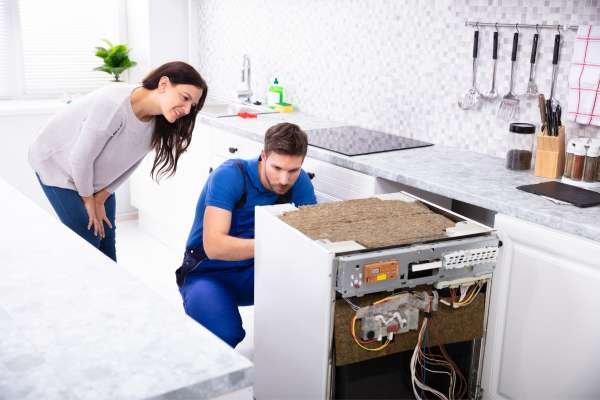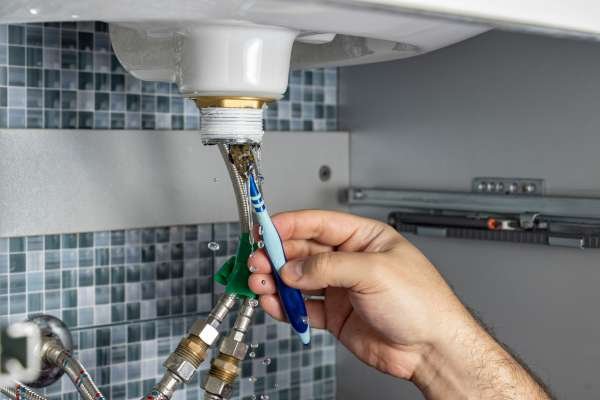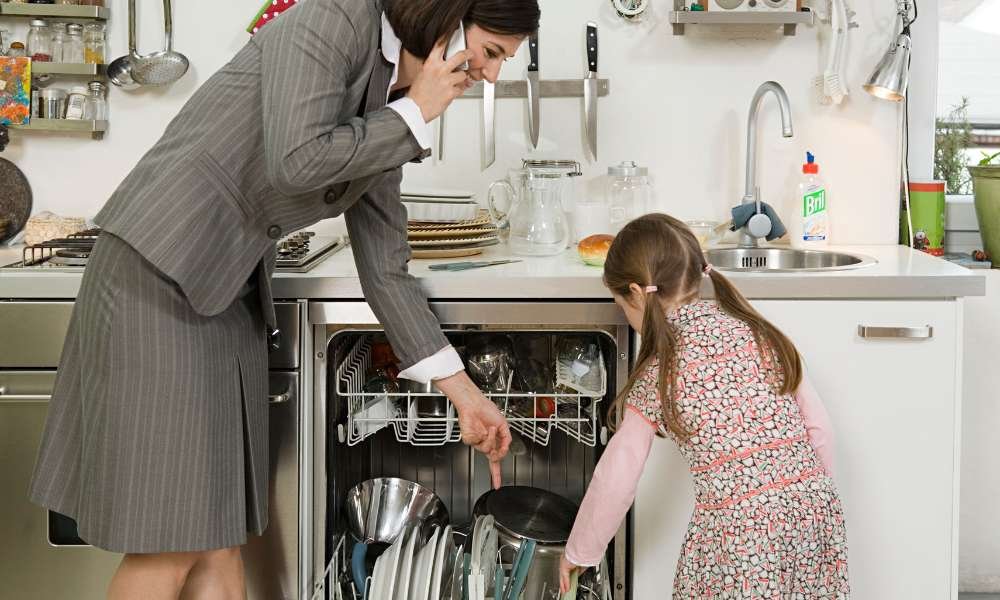Dishwasher Filling With Water But Not Running to wash the dishes can be both perplexing and frustrating. At first glance, it may seem like a major mechanical failure. However, understanding the common reasons behind this issue and how dishwashers work will help you troubleshoot effectively. When the dishwashers fills but stops, it’s a sign that while the water inlet functions properly, something in the subsequent cleaning cycle is failing.
Common Causes Behind a Dishwasher Filling with Water but Not Running
Several reasons could explain this issue. Power supply interruptions, door latch malfunctions, control panel errors, float assembly problems, and faulty components like the water inlet valve, timer, or thermal fuse can disrupt the cleaning cycle. Identifying the right cause will require checking each element systematically.
How a Dishwasher Works: The Basics You Should Know
A dishwasher operates through a series of steps: it fills with water, heats it, sprays it through rotating arms, drains the water, and then dries the dishes. If the dishwashers fills with water but doesn’t run, it means the process is getting interrupted before the wash cycle can begin. The root cause could be a mechanical blockage, an electrical failure, or a safety mechanism halting the cycle.
Is It Really a Problem? Signs Your Dishwasher Isn’t Starting Properly
Before diving into repairs, look for signs indicating a malfunction. These include an unusually silent dishwashers after filling, error codes flashing on the control panel, or a door that doesn’t click shut. It’s also worth checking if the water remains inside without any draining or if the dishwashers emits a humming sound without actual operation.
Step-by-Step Troubleshooting Guide
Here’s a logical approach to diagnosing and fixing the issue:
1. Check the Power Supply
Ensure that the dishwasher is plugged in and that the circuit breaker hasn’t tripped. Sometimes, power interruptions can cause the dishwashers to stop after filling.
2. Inspect the Door Latch and Switch
A faulty door latch or switch will prevent the dishwasher from running. If the door isn’t securely closed, the control system won’t allow the machine to proceed to the wash cycle.
3. Examine the Control Panel for Errors
Modern dishwashers often display error codes if something goes wrong. Refer to the user manual to interpret these codes and determine the next steps.
4. Look Into the Float Assembly
The float assembly monitors water levels inside the dishwasher. If the float is stuck in the “full” position, it can prevent the wash cycle from starting by signaling that the machine is overfilled.
5. Test the Water Inlet Valve
A malfunctioning water inlet valve might cause the dishwasher to fill with too much water or fail to shut off, triggering safety mechanisms that prevent the wash cycle from starting.
6. Assess the Timer or Electronic Control
The timer or electronic control module manages the sequence of the dishwasher’s functions. If this component fails, it can interrupt the cycle before the washing phase begins.
7. Review the Thermal Fuse and Motor
The thermal fuse protects the dishwashers from overheating, while the motor powers the spray arms. If either component is damaged, it may result in a dishwashers that fills with water but doesn’t proceed to wash.
When to Reset Your Dishwasher and How to Do It
If your dishwasher is filling with water but not running, a simple reset can often solve the issue. Many modern dishwashers have built-in reset options, often accessible through a combination of button presses or by disconnecting the power for a few minutes. Resetting clears software glitches, control panel errors, or stalled cycles. When your dishwashers fills but doesn’t run, and you hear no mechanical noises or see flashing lights on the display, try resetting before diving into more complex troubleshooting.
DIY Fixes You Can Try at Home (No Tools Required)
Before calling a technician, there are several simple steps you can try. First, ensure the dishwasher door is fully closed and latched. Next, check for error codes on the display panel and consult your user manual. Sometimes, cleaning around the door seal and float assembly can help free up stuck parts. Pressing and holding the start/cancel button for several seconds may also clear a paused cycle. If your dishwashers is plugged into a wall outlet, unplug it for a few minutes, then reconnect and start a new cycle.
Types of Dishwasher Issues Related to Water and Cycle Start
When a dishwashers fills with water but doesn’t run, the root cause may fall into a few broad categories. These include electrical problems like blown fuses or faulty wiring, mechanical malfunctions involving the door latch or motor, blockages in the water system, and software glitches in the control panel. Pinpointing the type of issue can guide you toward the right solution.
Electrical Problems

Electrical issues are a common cause of cycle disruptions. A dishwasher requires a continuous power supply to operate. A tripped breaker, blown fuse, or loose wiring connection can cause the dishwasher to fill but not start. Additionally, if the thermal fuse—a component that protects the dishwasher from overheating—blows, it will cut power to critical systems, stopping the cycle.
Mechanical Malfunctions

Mechanical parts like the door latch, motor, or pump are essential for the dishwashers to run. If the latch doesn’t signal the door is closed, the control system will not initiate the cycle. Similarly, a malfunctioning pump motor won’t circulate water through the spray arms, resulting in the dishwasher filling with water but remaining idle.
Blockages and Drainage Issues

A dishwasher that fills with water but doesn’t move into the wash cycle may be experiencing blockages. The float assembly, which monitors water levels, can become stuck in the “full” position if debris clogs it. Drainage issues, such as a clogged drain hose or filter, can also prevent the dishwasher from progressing beyond the fill phase. Even though water enters, the machine won’t advance to washing or draining.
Software or Control Panel Glitches
Modern dishwashers rely on electronic control boards to manage cycles. Sometimes, these boards develop software glitches or suffer from damaged wiring, causing them to halt mid-cycle or after filling with water. If the control panel is unresponsive or flashing error codes, a reset may fix the issue. However, persistent problems may require replacing the control board or keypad.
When to Call a Professional Technician
While some dishwashers issues can be resolved with DIY fixes, persistent problems like a dishwasher filling with water but not running may require professional assistance. If you’ve checked the power supply, door latch, control panel, and float assembly but the machine still refuses to operate, it’s time to contact a technician. A professional can safely diagnose and repair complex issues, such as a malfunctioning motor, damaged electronic control board, or faulty wiring. Additionally, if your dishwasher is under warranty, a certified technician can ensure that repairs are covered and performed correctly.
Tips to Prevent Future Dishwasher Start-Up Problems
Prevention is key to avoiding dishwasher start-up issues. Regularly inspect and clean the door latch, float assembly, and filters to prevent blockages. Avoid overloading the dishwashers, as this can strain mechanical components and lead to operational failures. Also, use the recommended detergent and follow the manufacturer’s guidelines for loading dishes. Running a dishwasher cleaner through a cycle every few months helps keep internal parts free of grease and buildup, ensuring smooth operation.
Understanding Your Dishwasher’s Error Codes and What They Mean
Many modern dishwashers display error codes when something goes wrong. These codes can offer valuable clues about why your dishwashers fills with water but doesn’t run. For example, codes might indicate a door latch failure, a water inlet problem, or a control board error. Refer to your user manual to interpret these codes and understand the underlying issue. Recognizing error codes early can help you take appropriate action before the problem worsens.
How to Properly Maintain Your Dishwasher for Smooth Operation
Routine maintenance is essential for keeping your dishwasher running efficiently. Check and clean the spray arms, filters, and drain regularly to prevent blockages. Inspect the door seal and gasket for wear, and replace them if necessary to ensure a proper seal. Test the float assembly periodically to ensure it moves freely, and examine the power cord and connections for signs of wear or damage. Keeping your dishwasher clean, well-maintained, and in good working order will reduce the likelihood of unexpected breakdowns.
Final Thoughts
A dishwasher that fills with water but doesn’t run can be a frustrating inconvenience, but understanding the common causes and taking proactive steps can help you fix the problem or prevent it altogether. Start with simple checks, such as ensuring the door latch is secure and the power supply is intact, and consult your manual for error codes. If basic troubleshooting doesn’t resolve the issue, a professional technician can provide expert repairs. With regular maintenance and care, Your dishwashers will continue to perform efficiently for years to come.
